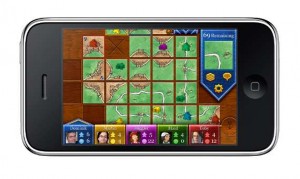 This is a review of the card game Nile from Minion Games, designed by Daniel Callister with publisher editing by James Mathe.
This is a review of the card game Nile from Minion Games, designed by Daniel Callister with publisher editing by James Mathe.
Disclosure: James sent me a free review copy.
Summary: A light high-luck card game suitable and possibly more interesting to children, sort of enjoyable for grown ups, with poor quality components and rules.
Overview: James is enthusiastic about Nile, one of four games with which he has started his company Minion Games. It’s easy to see why from first glance. It’s a light and simple game, with quick decisions, potential for take-that moments, and a Knizia-style trackable but hidden scoring system.
The deck contains 5 types of resources, 10 types of “speculation” cards each featuring 2 of the 5 resources, and a plague “Plague of Locusts” card.
On your turn:
1. Flip the top card into the discard pile. This has three effects:
1A: If it is a resource card, the player with cards of that resource in play (“planted”) takes one of them and puts it into his score pile (“harvests”). Note that each resource can only be in play in front of one player at any one time. If the flipped card is a speculation card, both resources are “harvested”.
1B: If the previous player played any speculation cards, and these have not yet been discarded, that player draws three cards from the deck for each match between the symbols on his speculation cards and the flipped card. The speculation cards are discarded, even if they didn’t match anything.
1C: In step 3, the player may not plant any cards whose resources match the resources on the flipped card.
2. As many times as you like, trade two cards from your hand and/or score pile to receive a new card to your hand, or to repeat step 1.
3. Do only one of the following:
3A: “Plant” at least two cards of a single resource in front of you if a) it is does not match (either) resource of the card flipped in step 1 and b) you plant more cards of that resource than any other player has in play. If any other player had cards of that resource in play, these cards are discarded.
3B: Plant exactly two cards of two different resources. Again, you can’t plant a resource if it matches the flipped card from step 1 or if someone else already has cards of that resource in play.
3C: Add as many cards as you like to any/all resources you have in play. Again, you can’t plant a resource if it matches the flipped card from step 1.
3D: Play one or two speculation cards. Again, you can’t play a speculation card if either resource on the card matches (either) resource of the card flipped in step 1.
4. Draw two cards.
Continue until exhausting the deck as many times as there are players. When the plague card is turned up, as it will once during each run through the deck, the biggest pile(s) of resources in play is discarded. The plague card is discarded and the player draws a card to replace it.
The winner is the player whose score pile contains the most sets of resources of all five types. Or, to put it in more complicated terms, everyone sorts their scored resources into piles, from least (this may be 0 cards) to most. The player with the most cards in the resource in which he has the least cards in the winner. If there is a tie, the tied players then compare their next lowest resources, and so on.
Components: Suck. The cards are poor quality; after a few plays, mine are falling apart (faces separating from backs by the edges). The graphics of the resource cards are nice enough, but the speculation cards are hard to read, so everyone squints at them when they are flipped up to see what resources they contain. There is a “flood” card that serves no purpose but to distinguish between the “flipped cards” discard pile and a separate discard pile for cards actually discarded. It’s not necessary, and in fact tends to get mixed back into the deck by accident.
Luckily I don’t care much about component quality.
Rules: Eh. My summary above is clearer than the two pages of rules that come with the game. The rules are not organized well and can appear to be contradictory. For instance, on one page it says that you can’t plant a resource that another player already has. On the next page, it says that you can’t plant a resource that another player already has unless you play more cards than they have in play.
Other clarity problems abound, but in the end, the rules are short and can eventually be deciphered.
Play: So how does it play? Eh. I played the game with 3 to 5 players. Another blogger recommended that I try it with 2 players; James says that 3 or 4 is best. As a rule, the younger players, aged 8 to 14, liked the game. The older players’ feelings ranged from “ok” to “too random” to “no thanks”. I fall kind of in the middle.
It’s certainly very luck driven: when you can plant cards, and when you get to harvest cards. You get the feeling that step 2 – trading – was added to mitigate that luck, which it does to some extent. But the plague card wipes away that mitigation, causing the player who actually planned and played well to suffer for having done so.
Once people grasp the four actions permitted in step 3 (for some reason, they took a lot of repeating to sink in), rounds play quickly. Lighter and quicker games get some leeway for having more luck, but this one was too far on the lack of control side. There was some enjoyment from the chaos of an occasional turnaround: one player played a lot of cards of one resource, causing another player to lose his resources, or a plague wiped out someone’s large resource planting just after he planted it. But we didn’t feel that you had a real chance to win unless you picked just the right cards at the right time.
People who enjoy light, chaotic games that our group doesn’t, such as Take 6, will enjoy the game.
- Comments Off on Second Look—Nile by Minion Games
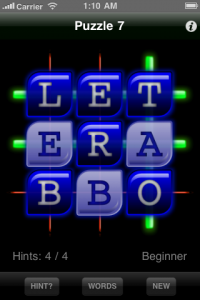 I’ll keep this pretty short tonight, because I pretty much explained the entire game in my first post.
I’ll keep this pretty short tonight, because I pretty much explained the entire game in my first post.
At first I wasn’t too impressed. The graphics are OK, and it was good enough for a quick 5 minute game or so.
Then I came back to it. Then again. Then again.
You see, I can’t stop playing the game. If I’ve got 5 minutes with nothing to do, I play it on my iPhone. If I’m standing at my desk waiting for something to compile for work, I play it on my iPad.
I’ve gone through a ton of puzzles, and I’m getting quite good at figuring out the beginner puzzles. I think it’s time to step up the difficulty.
Would I recommend it? Yeah. For a game I thought I really wasn’t that into, I’m sure playing it a lot.
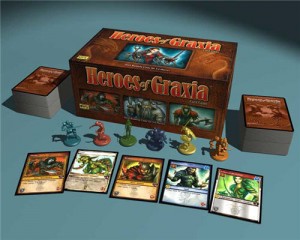 OK, OK. I know we’ve already posted a Second Look of Heroes of Graxia, but Petroglyph was nice enough to send me a review copy, so I thought I’d post some additional thoughts on the game.
OK, OK. I know we’ve already posted a Second Look of Heroes of Graxia, but Petroglyph was nice enough to send me a review copy, so I thought I’d post some additional thoughts on the game.
So you know Heroes of Graxia is one of the newer games that follows the trend of deck building games. I’ve never played Dominion or Thunderstone, so I can’t really compare this to either of those. I’m also not going to rehash what we’ve already covered about the game.
What I will talk about is how enamored I’ve become with the game after my first play. I admit the rules could have been written better, but we caught on pretty fast about 1/3 of the way through our first game. The biggest thing that stood out to me in Heroes is the amount of forward thinking you have to do. At all times you need to make sure you’re legion is strong enough to kill monsters, that you’re legion can withstand an attack from your opponents, and that you’re using gold wisely to buy both powerful cards, and cards that are worth enough victory points at the end.
The game ends when the monster deck is depleted, or a player earns a certain amount of prestige points (the number of which is decided by how many players are playing the game.) I should mention the only way to earn prestige points is by attacking other players and defeating their units.
There’s a lot of game in the tiny box, and it’s a game I see myself coming back to again and again. Now all I need is some card protectors, and some expansions!
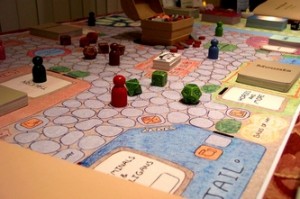 Josh Graye sent us a heads up of a new RPG board game that he and his wife have designed. The game is Heroes of Feonora, and it’s a massive print-and-play game. The game can handle up to 6 players, and cen even be played solo. It’s co-op, but only one player can earn the “Hero Award.”
Josh Graye sent us a heads up of a new RPG board game that he and his wife have designed. The game is Heroes of Feonora, and it’s a massive print-and-play game. The game can handle up to 6 players, and cen even be played solo. It’s co-op, but only one player can earn the “Hero Award.”
The game allows players to create a custom character that levels like in a traditional RPG. There’s also some traditional role playing elements in the game.
While I’ve only skimmed the rules at this point, but the game looks like it has some serious promise. I plan on putting together a set soon, and giving a thorough Second Look.
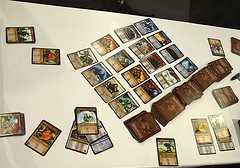 I couldn’t buy it and they wouldn’t let me steal their demo copy (believe me, I considered it…), but I did get to sit down and play Petroglyph Games’ upcoming deck-building game, Heroes of Graxia. You know what? Whatever you’re currently thinking about this game, you’re probably wrong. This one is a winner.
I couldn’t buy it and they wouldn’t let me steal their demo copy (believe me, I considered it…), but I did get to sit down and play Petroglyph Games’ upcoming deck-building game, Heroes of Graxia. You know what? Whatever you’re currently thinking about this game, you’re probably wrong. This one is a winner.
The gameplay starts out looking an awful lot like Dominion. Draw five cards from a pre-defined starter deck. Take two actions (play or attack) and then buy new cards with whatever you have left over. Discard all the cards you used for money and the ones you bought and then draw a new hand of five cards. But there are a few twists – you start play with a hero who is pretty butch and can receive equipment (which are cards you can buy). He also can be joined by new legions (which are also cards you can buy) which can also be equipped. Other cards for purchase include spells which can influence combat or create havoc in enemy ranks.

Remember those cards you were buying? They’re not static. They’re laid out in a grid and every time you buy one, it’s replaced with a new card of the corresponding type at random. All of this adds a really interesting pacing to the game that is really enjoyable.
Yeah, yeah, but what about the combat? Is there really player interaction in a deck-building game? You betcha. Each game includes a set of monsters who can be attacked. Beat a monster and you get a number of victory points (and these monsters hit pretty hard). Here’s where it gets interesting – instead of attacking a monster, players can attack each other. Overextend yourself (attacking a particularly nasty monster can cause you really rack up some damage) and one of your fellow players will come over and take you apart. Killing off a legion nets a player prestige points which indicate when the game is over (you get a prestige point just for attacking another player – this can be a pretty savage little game).
I really enjoyed this title and can see it being a sleeper hit when it releases in September (or early release at Gencon).
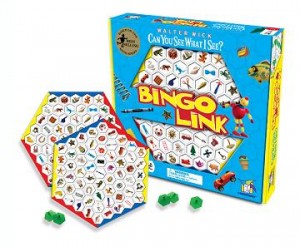 The following is a guest post by my wife, Robin. Gamewright sent me a complimentary copy of Bingo Link and Robin, who is active in a mutual support group for mothers of children with special needs, thought the game’s developmental benefits deserved some special attention.
The following is a guest post by my wife, Robin. Gamewright sent me a complimentary copy of Bingo Link and Robin, who is active in a mutual support group for mothers of children with special needs, thought the game’s developmental benefits deserved some special attention.
Finding a fun, short-play game that adults and kids can enjoy together, or that your six-year-old can play with your ten-year-old, can be a challenge. And what about a game that engages typical children and kids with special needs? Gamewright’s Bingo Link fills the bill. The images are drawn from Walter Wick’s charming Can You See What I See? series of books, but players do not have to be familiar with the books to enjoy the game.
Bingo Link is a game for two to four players ages six and up. It takes the basic make-a-straight-line bingo card concept onto a bright, colorful hexagonal board, with pictures of 61 eyecatching objects in die cut hexagonal spaces. To win the game, a player must cover a continuous—but not necessarily straight—line of objects from one side of the board to the other side of the same color (red, blue, or yellow). While each board has the same set of objects (including the iconic character, Seymour), they are arranged differently. Players can get further variety by orienting the boards differently each game. Spaces are covered with translucent plastic markers that feature a finger grip. On each turn, a player calls out the name of any object on his or her board and covers it with a marker. Each player covers the same object. The game can be played with boards hidden or revealed, which can add a strategic challenge if a player is trying not to call a particular object to prevent another player from completing a line.
In addition to being fun, Bingo Link lends itself to a variety of therapeutic applications. Placing the hexagonal markers into the die cut spaces is great for fine motor skills, pincer grasp practice and visual-spatial coordination. The colorful board encourages use of the full visual field, prereading scanning and visual discrimination. If a player doesn’t know the name of an object, the rules could easily be modified to allow a brief description instead, e.g. instead of “crab,” “green creature with eight legs and claws.” This small change in the rules could help players with a developmental or cognitive issue, without disrupting the mechanics of the game.
With all the great ways there are to play Bingo Link, and the wide variety of players that will enjoy it, it belongs in your game collection.
- Comments Off on Second Look — Bingo Link
Second Look—Carcassonne for the iPhone
14 Jun
Posted by Rob Kalajian as Electronic Games, Modern Board Games
2 words. Sheer perfection.
Carcassonne for the iPhone is not only the best looking iPhone game I’ve ever laid my hands on, it’s on of the best looking iPhone apps PERIOD. The look, the feel, how it plays, and even how it sounds are top notch.
You can play classic Carc against bots, other players via local WiFi or bluetooth, multiplayer over 3g, and even “Play by Notification”, where the game will notify you when it’s your turn against an opponent. The game even features a solo mode where you’re trying to create runs of 2, 3, 4+ segments of roads and cities before running out of resources.
Right now the iPhone app just contains the base game, but expansions are coming. I can’t wait to get my hands on the River, Inns & Cathedrals, and Traders and Builders.
This game scratches all the right itches, and is damn near perfect. There’s only ONE issue I have with the game. For those of you who aren’t interested in TMI, stop reading now, because it’s story time.
So I’m a work, and I’ve just sent a coworker an invite for a Play by Notification game. Then it hits me…I need to use the facilites. I head to the bathroom, thankful I’m the only one in there. I’m standing in front of a urinal when all of a sudden I hear, an extremely loud, “IT’S YOUR TURN.” Totally freaked out for a minute, I realize that this horrifying sound is my iPhone letting me know it’s my turn in Carcassonne. Not cool. Thankfully there were no major…disasters…because of this.
In conclusion, if you have an iPhone then you need to buy Carcassonne. Yesterday. Just be warned of the annoying notifications, and make sure you immediately turn them off.
Carcassonne for the iPhone is currently available for $4.99 from the iTunes App Store, but will go up to $9.99 once the universal iPhone/iPad version comes out. If you buy it now at $4.99, the universal version will be a free upgrade when it’s released.
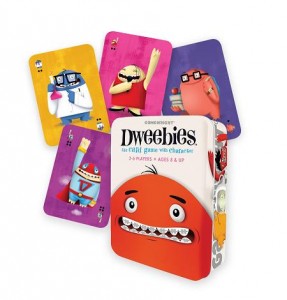 The following is a guest post by my daughter, Barrie. Gamewright sent me a complimentary copy of their new card game Dweebies, and it’s been such a hit with my family that Barrie asked to write the review.
The following is a guest post by my daughter, Barrie. Gamewright sent me a complimentary copy of their new card game Dweebies, and it’s been such a hit with my family that Barrie asked to write the review.
The game Dweebies is a very interesting game. The Dweebies are very cute. I like how you have to match up the Dweebies on both ends to collect the cards. One of the fun things about the game is that there isn’t always an even number of cards. Some of the Dweebies are Scientist Dweebie, Doctor Dweebie, Chef Dweebie, and Artist Dweebie.
I like how the game works. You don’t know if you’re going to get the cards or someone else will put down the card before you. One thing that isn’t so fun is that on some turns you have to put down a card somewhere even if you don’t want to [Ed.: when there are unconnected cards in the play area, the next player is required to fill in the gap]. Another thing I don’t like about the game is that sometimes you don’t know what the Dweebies are. Dweebies isn’t the most challenging game but it is very fun and cute.
I recommend this game to someone who is looking for a card game. The cards for the game are sort of thick so they are good and they will last. I like the game because the cards are very cute and funny. The game is a good game to play with the whole family. Dweebies is not too hard to play so it is easy to play with little kids.
- Comments Off on Second Look — Dweebies
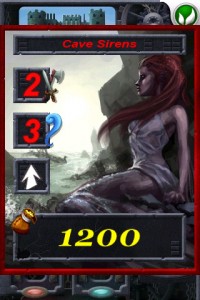 This isn’t a Second Look in the traditional sense on Purple Pawn, as we haven’t previously covered any news of the game before. I have, however, heard much about this game on The Dice Tower, and decided it was worth looking into.
This isn’t a Second Look in the traditional sense on Purple Pawn, as we haven’t previously covered any news of the game before. I have, however, heard much about this game on The Dice Tower, and decided it was worth looking into.
Dungeon Solitaire is a card game for the iPhone created by Griptonite Games, the company that also put out the fantastic iPhone version of Reiner Knizia’s Poison. The game and it’s interface are very professional, well made, and polished. The object of the same is simple, get 5 heroes into your hero column, then draw another hero to win.
Of course, it’s VERY hard to do this.
Let’s talk a bit about how the game board is set up. On the left of the screen you have the monster column. To the right of that is the hero column. Above those two columns is you castle. On the right side of the screen is the draw pile, a place to show the current card you’ve drawn, and a discard pile used to place items you cannot use.
Every turn you’ll draw a card. The card may be a monster, hero, item, enchantment, or trap. Monsters and heroes have 3 boxes on them. The first box is the attack power of the monster/hero, while the second is the magic power. The third box is designated for a special power, which not every monster/hero has. More on this later.
Items, enchantments, and traps generally have 2 boxes on them. These are modifiers to attack and magic. Each hero can equip only 1 item, and that’s it. Enchantments can be played on any hero, and traps are played into a column, and they’re effects take place on whatever card is placed on top of them.
Now let’s get more into the game itself.
After drawing a card, you have to use it. If it’s a monster, you place it in the monster column. The column can hold up to 5 monsters. If you draw a monster while the column is full, the creature hits your castle and does damage. Do this 3 times and you lose. If you draw a hero, you place it in the hero column, which also holds 5 cards. Fill this, draw one more hero, and you win. If you place a hero and a monster next to each other, they battle. If one card’s numbers are BOTH higher than the other, that card wins, otherwise the cards draw.
2 things can happen when cards draw:
1. Nothing
2. The attacking card’s special power is activated.
Special powers come into play a LOT during the game, and are where any real strategy comes in. There are several powers a card can have. Sometimes a card will bump it’s opponent up or down in the column, forcing any other cards it pushes in the same direction. Some special powers spawn a copy of the current card, and some even outright destroy any card that creature/hero ties with. There’s a few others, but I haven’t really figured out what they do yet.
Each creature you defeat gives you gold, which is basically your score. Winning the game gives you a bonus, and there’s a high score chart and online leader boards so you can see how well you’ve done against other players.
I’ve already written a lot about the game, and there’s probably more still to write on the various power ups, strategies, expansion decks, and more. In the end, i’d HIGHLY recommend snagging Dungeon Solitaire from the iTunes App Store. The game is quick, addictive, and fun. There’s a few free card expansions, and a few paid expansions that add all sorts of new things to your deck. One of the best things about Dungeon Solitaire is the price. It’s only $1.99. Not too shabby for such a great game.
Promotional consideration was given by Griptonite games in the form of a free copy of Dungeon Solitaire.
- Comments Off on Second Look—Dungeon Solitaire
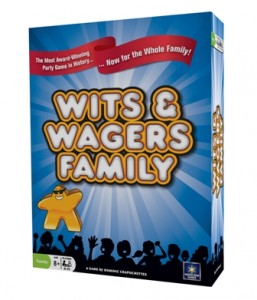 Back in January I had posted about the release of Wits and Wagers Family at the NY Toy Fair.
Back in January I had posted about the release of Wits and Wagers Family at the NY Toy Fair.
Well I can now say that I’ve played the game, thanks to North Star games sending me a copy to review. Keep in mind that I’ve never played the original, so this review will focus on how the game stands on its own, not how it compares to Wits And Wagers.
Contents of the box:
150 question cards
5 big meeples
5 small meeples
5 dry erase boards and pens
1 dry erase score board
1 answer board
The rules
Gameplay:
The game play for Wits & Wagers Family couldn’t be easier. A question is asked and all the players write down a guess. These guesses are revealed, and placed in order from smallest to largest (answers are always numeric). Now all the players place their meeples onto the answer they think is correct, or at least the closest to the correct answer.
Points are then awarded as follows:
2 points if you guessed correctly with your large meeple
1 point if you guessed correctly with your small meeple
1 point if you guess the closest to the right answer.
As you can see it’s possible to earn up to 4 points each question. The beauty of this system is that you don’t need to know the right answer to the question to do well in the game. No one does.
My Thoughts:
The game is incredibly simple to learn and play, and a ton of fun. I wouldn’t really play this with anyone younger than 8, but I’m sure there’s some astute 6 year olds that may be an exception to this. My only problem is that some of the questions are TOO easy. I understand this is a family game, but having a larger spread of questions for different age groups would have been nice. This could be easily fixed, though, with an expansion pack of questions, or even some homebrew questions. I will admit, however, that there were some questions that the adults had a much harder time answering than the kids.
All in all we had a great time with the game. Sure there’s better family party games out there, but Wits & Wagers Family deserves a spot on every family’s shelf. I may have to pick up the original now that I know how much fun the family edition is.
- Comments Off on Second Look—Wits & Wagers Family
Trending
- Home
- Are Board Games Dangerous?
- Battle Cry Online!
- The 20 Most Valuable Vintage Board Games
- Leave Your Paper Terrain in Ruins
- Inuktitut Scrabble
- Sid the Science Kid
- Oh the Irony—Illuminati Card Game Continues to Inspire Conspiracy Theorists
- Toy Fair 2016—Lego Ninjago Sky Pirates
- The Truth About Dominoes On Sunday in Alabama
Archives
Most Popular Articles
- The 20 Most Valuable Vintage Board Games
- Sequence Game, and Variants
- USPS Adds Board Game Flat Rate Box
- Baila, the Estonian Drinking Card Game
- The 13 Most Popular Dice Games
- The Truth About Dominoes On Sunday in Alabama
- Are Board Games Dangerous?
- Oh the Irony—Illuminati Card Game Continues to Inspire Conspiracy Theorists
- The Convoluted Story of Iron Wind Metals, Ral Partha, and Battletech Miniatures
- Guess Who? The Naked Version
Recent Posts
- Toy Fair 2019—Breaking Games
- Talisman Kingdom Hearts Edition
- Toy Fair 2019—Winning Moves
- Toy Fair 2019—Games Workshop
- Toy Fair 2019—Star Wars Lightsaber Academy
- Toy Fair 2019—Stranger Things Games
- Toy Fair 2019—HABA
- Licensing Roundup
- Game Bandit
- 2018 A Difficult Year For Hasbro But Not For D&D Or MtG
Recent Comments
- on Toy Fair 2019—Winning Moves
- on Game Bandit
- on Second Look—Dungeons & Dragons Waterdeep Dragon Heist
- on Crowdfunding Highlights
- on Beyblade SlingShock
- on Game Bandit
- on Game Bandit
- on Watch This Game!, the Board Game Review Board Game
- on Second Look—Vampire: The Masquerade 5th Edition
- on Palladium Books Loses Robotech IP License, Cancels Five-Year-Overdue Robotech RPG Tactics Kickstarter

